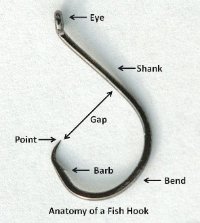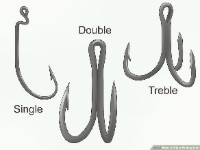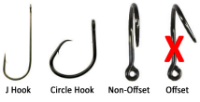Freshwater Fishing Hooks
To discover which freshwater hooks work best for a specific species of fish or fishing situation, talk to somebody at your local tackle shop. They'll often describe the best freshwater hooks for your needs and the different freshwater fishing hooks you can use.
Over the centuries, freshwater fishing hooks have been made of wood, animal and human bone, horn, shells, stone, bronze, and iron. Today, freshwater fishing hooks are manufactured from either high-carbon steel, steel alloyed with vanadium or stainless steel. Hook types can be named after the design of the point, barb, eye, shank, bend or size. With such a vast variety of features to choose from, choosing freshwater hooks can seem extremely daunting at first. However, with just a little patience and study (of the fishing environment), you’ll soon be a pro at choosing the best hooks for freshwater fishing for all situations you may likely encounter.
Anatomy Of Freshwater Fishing Hooks

Image credit: I, Mike Cline, CC BY-SA 3.0, \
Points
The point of a fish hook is the sharp end that penetrates the mouth or flesh of a fish. The profile of the fish hook point and its length determine how well the point penetrates.
Points are described by the direction of the point when looking directly down the line of the shank: straight (in line with the shank), kirbed (offset to the left) or reversed (offset to the right), and design of the point: needle point, rolled-in, hollow, spear, beak, mini-barb, semi-dropped and knife-edge. Thus, freshwater fishing hooks may be described as kirbed needle, or straight knife-edge, or reversed spear, or any other combination of direction and design noted above.
Barbs
The barb on a fishing hook is the projection extending backwards from the point that keeps the fish from unhooking. The length of the barb determines how much pressure is required to penetrate the point and hold the fish on the hook. In other words, how deep you need to set the hook.
Barbless freshwater hooks make hook removal and fish release less stressful on the fish, especially if you're doing catch-and-release fishing.
Eyes
The eye is the part of the fish hook that's used to connect the hook to the line or lure. Hook eye design is usually optimized for strength, weight and/or presentation.
Fishing hook eye types can be used to describe a certain kind of hook: ring or ball eye, brazed eye (the eye is fully closed), tapered eye (to reduce weight), looped eye (traditional on Atlantic salmon flies), needle eye and spade end (no eye at all, but a flattened area to allow attachment of the leader to the hook).
Eyes on freshwater hooks can also be positioned one of three ways on the shank—up-turned, down-turned, straight, ringed or lopped. So, much like the points of a hook, the eyes can also be described by direction and design: e.g., up-turned tapered eye.
Bend, Shank, Shape
Simply put, the bend is the “U” shaped part of the hook, connecting the side with the point to the side with the shank and eye. The shape of the hook shank can vary widely from merely straight to all sorts of curves, kinks, bends and offsets. And can contribute to better hook penetration, better fly imitations or better bait-holding ability.
Many freshwater hooks intended to hold dead or artificial baits have sliced shanks, which create barbs for better baiting holding ability.
Shank length can be used to describe a certain kind of hook, as in standard, extra-long, 2XL, short, etc. Shape names include Aberdeen, Sproat, Model Perfect, Limerick, Kirby, Carlisle, O'Shaughnessy, Pennell, Eagle Claw and Keel.
Sizes Of Freshwater Fishing Hooks
Fishing hook sizes are generally referred to by a number from the smallest (size 32) to the largest (size 19/0). For hook sizes from 32 to 1, the larger the number, the smaller the hook. For fish hook sizes from 1/0 (called a one aught) to 19/0, the larger the number the larger the hook.
Types Of Freshwater Fishing Hooks
In general, there are three types of freshwater hooks: bait-cast hooks, fly-cast hooks and bait and spin-cast lure hooks. But within these broad categories there are countless types of freshwater hooks for different species of fish and different fishing methods.
You may find hooks for freshwater fishing named for their general purpose (bait-cast, fly-cast and bait and spin-cast lure hooks). You may also see them named for one or more of their physical characteristics (point, barb, eye, bend, shank and size) or for a specific species of fish.
Finally, freshwater fishing hooks can be named for a combination of characteristics. Truth is, it can get a little confusing. So always ask for a translation.
Single, Double And Treble Hooks

Image credit:wikihow
Single hooks have a single eye, shank and point. But the eye, shank, point and bend characteristics can be combined to create hundreds of different hooks for different types of fish and fishing methods. Most sport fish are caught on some sort of single hook, whether it's a hook with bait attached, a hook attached to a lure or hook with a fly.
Double hooks have a single eye merged with two shanks and points. They're formed from a single piece of wire and may or may not have their shanks brazed together for strength. Double hooks are molded into some artificial lures and are a traditional hook for Atlantic salmon flies. Otherwise they're uncommon.
Treble hooks have a single eye merged with three shanks and three evenly spaced points. They're formed by adding a single, eyeless hook to a double hook and brazing all three shanks together. Treble hooks are used on all sorts of artificial lures and for a variety of bait applications.
Circle Hooks

Image credit: Maryland DNR
These fishing hooks are most popular with catch-and-release anglers. They are designed to result in less damage by hooking the fish in the lip or the corner of the jaw. This makes it easier to unhook and release the fish. With a circle hook, it’s important to let the fish take the bait and turn away before setting the hook. Choose the right size hook to allow room for the bait and the fish lip. And make sure the hook is exposed and not buried in the bait.
Typical Fly Fishing Hook Shapes And Names\
Typical fly fishing hook shapes include Sproat, Sneck, Limerick, Kendal, Viking, Captain Hamilton, Barleet, Swimming Nymph, Bend Back Model Perfect, Keel and Kink-shank.
There are two basic types of fly hooks: dry and wet. Fly hooks are also named for the type of insects they simulate (nymph, swimming nymph, scub, pupa, mayfly) or by traditional shapes (Sproat, Sneck, Limerick, Kendal, Viking, Captain Hamilton, Barleet, Bend Back, Model Perfect, Keel, Kink-shank.).
To learn about different types of freshwater fishing rigs visit our next section.
KEEP LEARNING

First Catch Center Trailer Gallery
FCC Trailer Photo Gallery
LEARN MORE

How to Tie a Duncan Knot
Learn to tie a Duncan knot by following these five simple steps. Watch our new video.
LEARN MORE

Welcome to Angler Academy!
No one said you can’t bring fishing inside! There’s lots of fun activities we can do right from home
LEARN MORE


.png?lang=en-US&ext=.png)